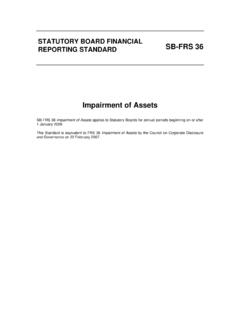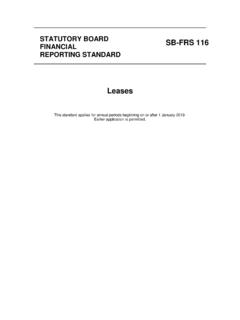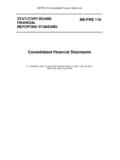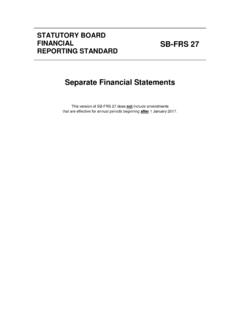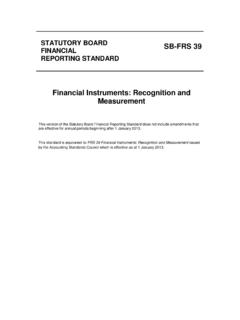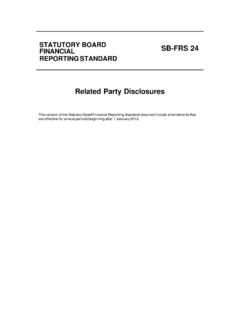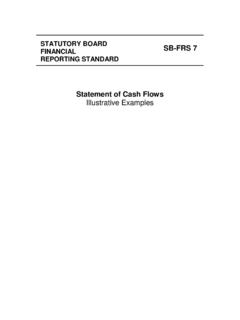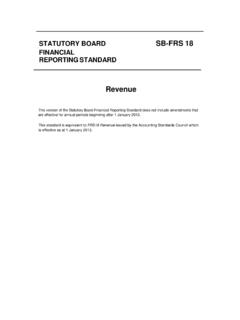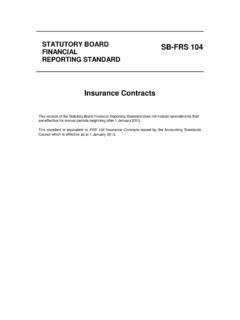Transcription of STATUTORY BOARD SB-FRS 38 FINANCIAL …
1 STATUTORY BOARD SB-FRS 38 FINANCIAL reporting STANDARD Intangible Assets This version of the STATUTORY BOARD FINANCIAL reporting Standard does not include amendments that are effective for annual periods beginning after 1 January 2013. This standard is equivalent to FRS 38 Intangible Assets issued by the Accounting standards Council which is effective as at 1 January 2013. SB-FRS 38 CONTENTS OBJECTIVE SCOPE DEFINITIONS Intangible assets Identifiability Control Future economic benefits RECOGNITION AND MEASUREMENT Separate acquisition Acquisition as part of a business combination Intangible asset acquired in a business combination Subsequent expenditure on an acquired in-process research and development project Acquisition by way of a government grant Exchanges of assets Internally generated goodwill Internally generated intangible assets Research phase Development phase Cost of an internally generated intangible asset
2 RECOGNITION OF AN EXPENSE Past expenses not to be recognised as an asset MEASUREMENT AFTER RECOGNITION Cost model Revaluation model USEFUL LIFE INTANGIBLE ASSETS WITH FINITE USEFUL LIVES Amortisation period and amortisation method from paragraph 1 2 8 9 11 13 17 18 25 33 35 42 44 45 48 51 54 57 65 68 71 72 74 75 88 97 97 2 SB-FRS 38 Residual value Review of amortisation period and amortisation method INTANGIBLE ASSETS WITH INDEFINITE USEFUL LIVES Review of useful life assessment RECOVERABILITY OF THE CARRYING AMOUNT IMPAIRMENT LOSSES RETIREMENTS AND DISPOSALS DISCLOSURE General Intangible assets measured after recognition using the revaluation model Research and development expenditure Other information TRANSITIONAL PROVISIONS AND EFFECTIVE DATE Exchanges of similar assets ILLUSTRATIVE EXAMPLES (See separate document) Assessing the useful lives of intangible assets 100 104 107 109 111 112 118 118 124 126 128 129 130 3 SB-FRS 38 STATUTORY BOARD FINANCIAL reporting Standard 38 Intangible Assets ( SB-FRS 38) is set out in paragraphs 1 133.
3 All the paragraphs have equal authority. SB-FRS 38 should be read in the context of its objective, the Preface to STATUTORY BOARD FINANCIAL reporting standards and the Conceptual Framework for FINANCIAL reporting . SB-FRS 8 Accounting Policies, Changes in Accounting Estimates and Errors provides a basis for selecting and applying accounting policies in the absence of explicit guidance. 4 SB-FRS 38 5 SB-FRS 38 STATUTORY BOARD FINANCIAL reporting Standard 38 Intangible Assets Objective 1 The objective of this Standard
4 Is to prescribe the accounting treatment for intangible assets that are not dealt with specifically in another Standard. This Standard requires an entity to recognise an intangible asset if, and only if, specified criteria are met. The Standard also specifies how to measure the carrying amount of intangible assets and requires specified disclosures about intangible assets. Scope 2 This Standard shall be applied in accounting for intangible assets, except: (a) intangible assets that are within the scope of another Standard; (b) FINANCIAL assets, as defined in SB-FRS 32 FINANCIAL Instruments: Presentation; (c) the recognition and measurement of exploration and evaluation assets (see SB FRS 106 Exploration for and Evaluation of Mineral Resources); and (d) expenditure on the development and extraction of minerals, oil, natural gas and similar non-regenerative resources.
5 3 If another Standard prescribes the accounting for a specific type of intangible asset, an entity applies that Standard instead of this Standard. For example, this Standard does not apply to: (a) intangible assets held by an entity for sale in the ordinary course of business (see SB FRS 2 Inventories and SB-FRS 11 Construction Contracts). (b) deferred tax assets (see SB-FRS 12 Income Taxes). (c) leases that are within the scope of SB-FRS 17 Leases. (d) assets arising from employee benefits (see SB-FRS 19 Employee Benefits). (e) FINANCIAL assets as defined in S B - FRS 32. The recognition and measurement of some FINANCIAL assets are covered by S B - FRS 27 Consolidated and Separate FINANCIAL Statements, SB-FRS 28 Investments in Associates and SB-FRS 31 Interests in Joint Ventures.
6 (f) goodwill acquired in a business combination (see SB-FRS 103 Business Combinations). (g) deferred acquisition costs, and intangible assets, arising from an insurer s contractual rights under insurance contracts within the scope of SB-FRS 104 Insurance Contracts. SB-FRS 104 sets out specific disclosure requirements for those deferred acquisition costs but not for those intangible assets. Therefore, the disclosure requirements in this Standard apply to those intangible assets. (h) non-current intangible assets classified as held for sale (or included in a disposal group that is classified as held for sale) in accordance with SB-FRS 105 Non-current Assets Held for Sale and Discontinued Operations. 4 Some intangible assets may be contained in or on a physical substance such as a compact disc (in the case of computer software), legal documentation (in the case of a licence or patent) or film.
7 In determining whether an asset that incorporates both intangible and tangible elements should be treated under FRS 16 Property, Plant and Equipment or as an intangible 6
8 SB-FRS 38 asset under this Standard, an entity uses judgement to assess which element is more significant. For example, computer software for a computer-controlled machine tool that cannot operate without that specific software is an integral part of the related hardware and it is treated as property, plant and equipment. The same applies to the operating system of a computer. W hen the software is not an integral part of the related hardware, computer software is treated as an intangible asset. 5 This Standard applies to, among other things, expenditure on advertising, training, start-up, research and development activities. Research and development activities are directed to the development of knowledge.
9 Therefore, although these activities may result in an asset with physical substance (eg a prototype), the physical element of the asset is secondary to its intangible component, ie the knowledge embodied in it. 6 In the case of a finance lease, the underlying asset may be either tangible or intangible. After initial recognition, a lessee accounts for an intangible asset held under a finance lease in accordance with this Standard. Rights under licensing agreements for items such as motion picture films, video recordings, plays, manuscripts, patents and copyrights are excluded from the scope of SB-FRS 17 and are within the scope of this Standard. 7 Exclusions from the scope of a Standard may occur if activities or transactions are so specialised that they give rise to accounting issues that may need to be dealt with in a different way.
10 Such issues arise in the accounting for expenditure on the exploration for, or development and extraction of, oil, gas and mineral deposits in extractive industries and in the case of insurance contracts. Therefore, this Standard does not apply to expenditure on such activities and contracts. However, this Standard applies to other intangible assets used (such as computer software), and other expenditure incurred (such as start-up costs), in extractive industries or by insurers. Definitions 8 The following terms are used in this Standard with the meanings specified: Amortisation is the systematic allocation of the depreciable amount of an intangible asset over its useful life. An asset is a resource: (a) controlled by an entity as a result of past events; and (b) from which future economic benefits are expected to flow to the entity.
